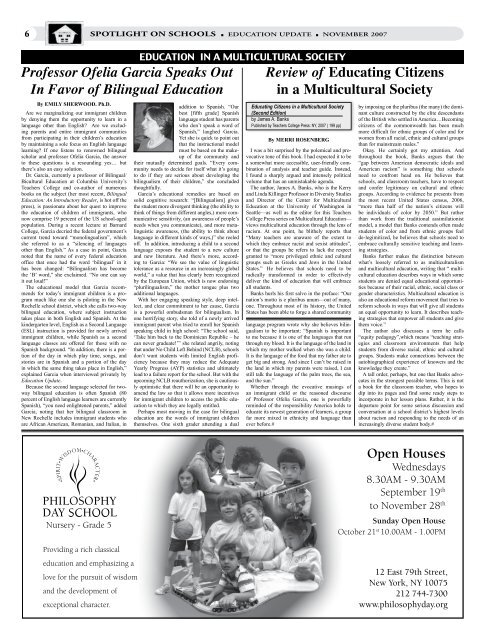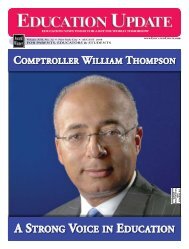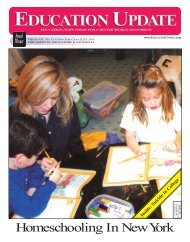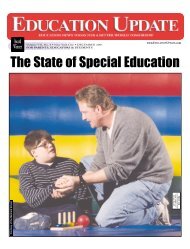Download PDF - Education Update
Download PDF - Education Update
Download PDF - Education Update
Create successful ePaper yourself
Turn your PDF publications into a flip-book with our unique Google optimized e-Paper software.
spotlight on schools ■ EDUCATION UPDATE ■ NOVEMBER 2007Professor Ofelia Garcia Speaks OutIn Favor of Bilingual <strong>Education</strong>By Emily Sherwood. Ph.D.Are we marginalizing our immigrant childrenby denying them the opportunity to learn in alanguage other than English? Are we excludingparents and entire immigrant communitiesfrom participating in their children’s educationby maintaining a sole focus on English languagelearning? If one listens to renowned bilingualscholar and professor Ofelia Garcia, the answerto these questions is a resounding yes… butthere’s also an easy solution.Dr. Garcia, currently a professor of Bilingual/Bicultural <strong>Education</strong> at Columbia University’sTeachers College and co-author of numerousbooks on the subject (her most recent, Bilingual<strong>Education</strong>: An Introductory Reader, is hot off thepress), is passionate about her quest to improvethe education of children of immigrants, whonow comprise 19 percent of the US school-agedpopulation. During a recent lecture at BarnardCollege, Garcia decried the federal government’scurrent trend toward “monolingualism”, whichshe referred to as a “silencing of languagesother than English.” As a case in point, Garcianoted that the name of every federal educationoffice that once had the word ‘bilingual’ in ithas been changed: “Bilingualism has becomethe ‘B’ word,” she exclaimed. “No one can sayit out loud!”The educational model that Garcia recommendsfor today’s immigrant children is a programmuch like one she is piloting in the NewRochelle school district, which she calls two-waybilingual education, where subject instructiontakes place in both English and Spanish. At thekindergarten level, English as a Second Language(ESL) instruction is provided for newly arrivedimmigrant children, while Spanish as a secondlanguage classes are offered for those with noSpanish background. “In addition, there is a portionof the day in which play time, songs, andstories are in Spanish and a portion of the dayin which the same thing takes place in English,”explained Garcia when interviewed privately by<strong>Education</strong> <strong>Update</strong>.Because the second language selected for twowaybilingual education is often Spanish (80percent of English language learners are currentlySpanish), “you need enlightened parents,” addedGarcia, noting that her bilingual classroom inNew Rochelle includes immigrant students whoare African American, Romanian, and Italian, in<strong>Education</strong> in a multicultural societyaddition to Spanish. “Ourbest [fifth grade] Spanishlanguage student has parentswho don’t speak a word ofSpanish,” laughed Garcia.Yet she is quick to point outthat the instructional modelmust be based on the makeupof the community andtheir mutually determined goals. “Every communityneeds to decide for itself what it’s goingto do if they are serious about developing thebilingualism of their children,” she concludedthoughtfully.Garcia’s educational remedies are based onsolid cognitive research: “[Bilingualism] givesthe student more divergent thinking (the ability tothink of things from different angles,) more communicativesensitivity, (an awareness of people’sneeds when you communicate), and more metalinguisticawareness, (the ability to think aboutlanguage in different kinds of ways,)” she reeledoff. In addition, introducing a child to a secondlanguage exposes the student to a new cultureand new literature. And there’s more, accordingto Garcia: “We see the value of linguistictolerance as a resource in an increasingly globalworld,” a value that has clearly been recognizedby the European Union, which is now endorsing“plurilingualism,” the mother tongue plus twoadditional languages.With her engaging speaking style, deep intellect,and clear commitment to her cause, Garciais a powerful ombudsman for bilingualism. Inone horrifying story, she told of a newly arrivedimmigrant parent who tried to enroll her Spanishspeaking child in high school: “The school said,‘Take him back to the Dominican Republic – hecan never graduate!’” she related angrily, notingthat under No Child Left Behind (NCLB), schoolsdon’t want students with limited English proficiencybecause they may reduce the AdequateYearly Progress (AYP) statistics and ultimatelylead to a failure report for the school. But with theupcoming NCLB reauthorization, she is cautiouslyoptimistic that there will be an opportunity toamend the law so that it allows more incentivesfor immigrant children to access the public educationto which they are legally entitled.Perhaps most moving in the case for bilingualeducation are the words of immigrant childrenthemselves. One sixth grader attending a dualReview of Educating Citizensin a Multicultural SocietyEducating Citizens in a Multicultural Society(Second Edition)by James A. BanksPublished by Teachers College Press: NY, 2007 ( 199 pp)by merri rosenbergI was a bit surprised by the polemical and provocativetone of this book. I had expected it to bea somewhat more accessible, user-friendly combinationof analysis and teacher guide. Instead,I found a sharply argued and intensely politicalvolume that has an unmistakable agenda.The author, James A. Banks, who is the Kerryand Linda Killinger Professor in Diversity Studiesand Director of the Center for Multicultural<strong>Education</strong> at the University of Washington inSeattle—as well as the editor for this TeachersCollege Press series on Multicultural <strong>Education</strong>—views multicultural education through the lens ofracism. At one point, he blithely reports that“Many teachers are unaware of the extent towhich they embrace racist and sexist attitudes”,or that the groups he refers to lack the respectgranted to “more privileged ethnic and culturalgroups such as Greeks and Jews in the UnitedStates.” He believes that schools need to beradically transformed in order to effectivelydeliver the kind of education that will embraceall students.Banks hurls his first salvo in the preface: “Ournation’s motto is e pluribus unum—out of many,one. Throughout most of its history, the UnitedStates has been able to forge a shared communitylanguage program wrote why she believes bilingualismto be important: “Spanish is importantto me because it is one of the languages that runthrough my blood. It is the language of the land inwhich my mother walked when she was a child.It is the language of the food that my father ate toget big and strong. And since I can’t be raised inthe land in which my parents were raised, I canstill talk the language of the palm trees, the sea,and the sun.”Whether through the evocative musings ofan immigrant child or the reasoned discourseof Professor Ofelia Garcia, one is powerfullyreminded of the responsibility America holds toeducate its newest generation of learners, a groupfar more mixed in ethnicity and language thanever before.#by imposing on the pluribus (the many) the dominantculture constructed by the elite descendantsof the British who settled in America…Becomingcitizens of the commonwealth has been muchmore difficult for ethnic groups of color and forwomen from all racial, ethnic and cultural groupsthan for mainstream males.”Okay. He certainly got my attention. Andthroughout the book, Banks argues that the“gap between American democratic ideals andAmerican racism” is something that schoolsneed to confront head on. He believes thatschools, and classroom teachers, have to respectand confer legitimacy on cultural and ethnicgroups. According to evidence he presents fromthe most recent United States census, 2006,“more than half of the nation’s citizens willbe individuals of color by 2050.” But ratherthan work from the traditional assimilationistmodel, a model that Banks contends often madestudents of color and from ethnic groups feelde-legimitized, he believes that schools need toembrace culturally sensitive teaching and learningstrategies.Banks further makes the distinction betweenwhat’s loosely referred to as multiculturalismand multicultural education, writing that “ multiculturaleducation describes ways in which somestudents are denied equal educational opportunitiesbecause of their racial, ethnic, social class orgender characteristics. Multicultural education isalso an educational reform movement that tries toreform schools in ways that will give all studentsan equal opportunity to learn. It describes teachingstrategies that empower all students and givethem voice.”The author also discusses a term he calls“equity pedagogy”,which means “teaching strategiesand classroom environments that helpstudents from diverse racial, ethnic and culturalgroups. Students make connections between theautobiographical experience of knowers and theknowledge they create.”A tall order, perhaps, but one that Banks advocatesin the strongest possible terms. This is nota book for the classroom teacher, who hopes todip into its pages and find some ready steps toincorporate in her lesson plans. Rather, it is thedeparture point for some serious discussion andconversation at a school district’s highest levelsabout racism and responding to the needs of anincreasingly diverse student body.#Nursery - Grade 5
















